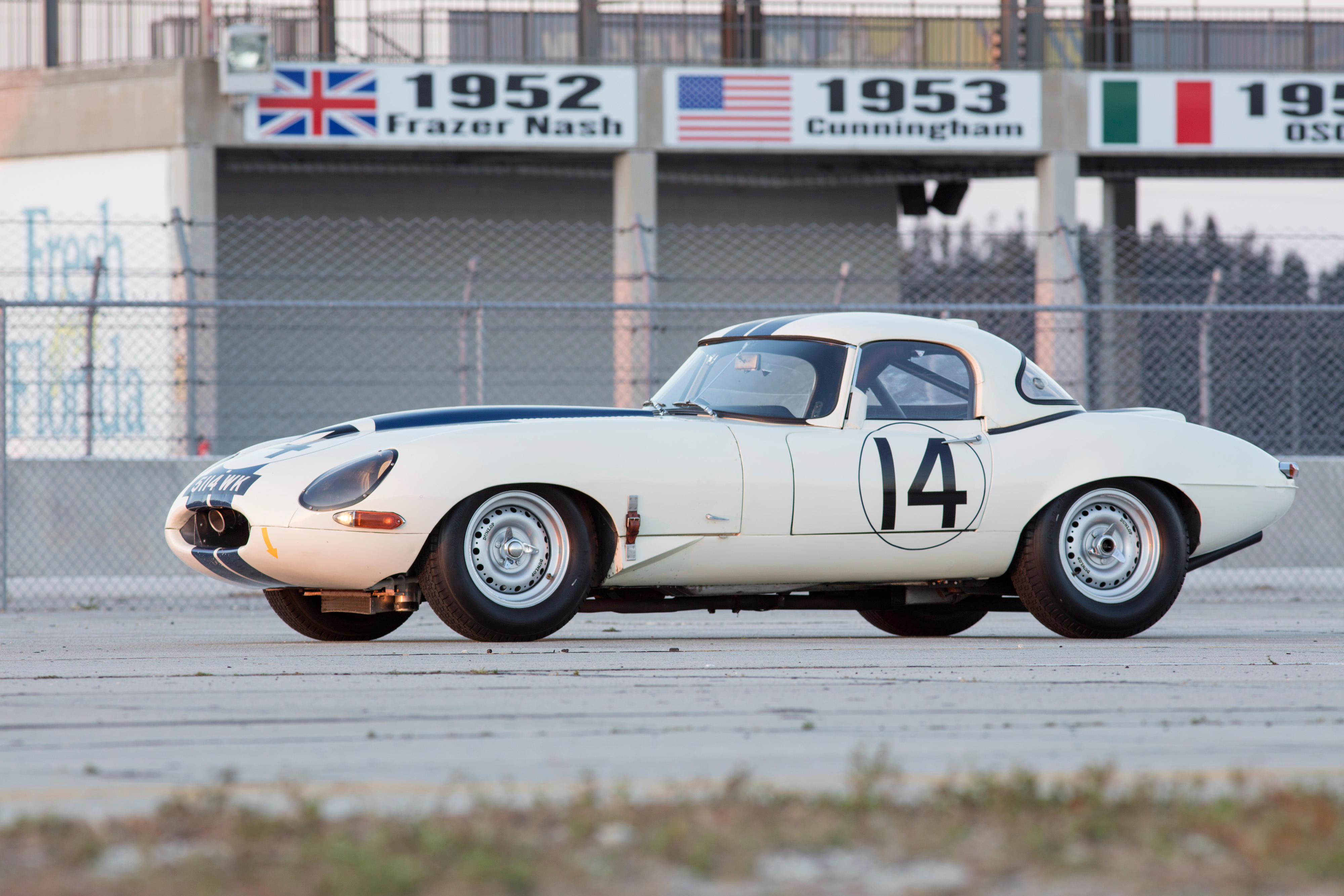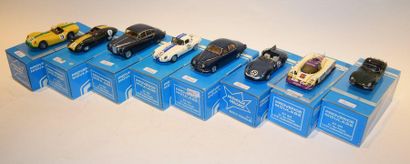331ci OHV Chrysler FirePower Hemi V8 Engine 4 Zenith Single-Barrel Carburetors 220bhp at 4,000rpm 4-Speed Chrysler Fluid-Matic Semi-Automatic Transmission 4-Wheel Coil Springs with Independent Front Suspension and Live Rear Axle 4-Wheel Hydraulic Drum Brakes *One of only 25 C-3s produced *Well known history *Runs and drives *Has been off the road for nearly 50 years *A very complete restoration project THE CUNNINGHAM C-3 The son of a wealthy banker, the aptly named Briggs Swift Cunningham would become the epitome of the American Sportsman thanks to his passion for speed, relentless drive, and access to ample funds. Beginning in 1940 racing his 'Bu-Merc'—a modified Buick chassis with a Buick engine and Mercedes-Benz SSK bodywork, he would seriously step up his racing efforts after WWII. In 1950, Cunningham entered a pair of Cadillacs Series' 60s in LeMans—a stock fastback coupe and an aerodynamic roadster with custom bodywork dubbed 'Le Monstre' by the by the French. Finishing 10th and 11th overall, the experience—along with his other racing efforts—led him to develop his own racecar in 1951. His debut effort, the Cadillac powered C-1 saw no track time given the lack of financial support from Cadillac. Turning to Chrysler, who was willing to sell its Hemi V8s to Cunningham at a 40% discount, in 1951 Cunningham developed the C-2R off the C-1's chassis. While powerful, the C-2 was hampered by its portly weight, DeDion rear axle, and 3-speed transmission that limited engine braking and put undue additional wear on the drums brakes. By this point, the organizers of LeMans had established a new rule requiring manufactures to homologate their racecars by producing at a number of road going units to participate in the race. Prompted by the rule—and looking to capitalize on selling road cars to fund his racing efforts, Cunningham set out to create a street version of the C-2R—the C-3. Featuring a ladder-tube frame similar to the C-2R's, the C-3 featured independent front suspension and a live rear axle, the latter of which weighed significantly less than the C-2R's DeDion rear axle. Power came from a 331ci Chrysler Hemi V8. After building one C2 body on a C-3 chassis, as a cost saving measure, bodywork was done by Vignale in Italy, with completed coachwork sent to Cunningham's West Palm Beach factory for final fitment. Retailing for $9,000 for a coupe and $10,000 for a convertible when new—nearly three times the price of a Corvette—only 25 complete C-3s would leave the factory. This was all that was needed, however, for Cunningham to continue his racing efforts—now with the improved C-4R. THE MOTORCAR OFFERED The fourth from last C-3 produced, and the antepenultimate of 20 Coupes built, this car was originally numbered 5232 but was renumbered by the factory to the number it carries today, 5440 (this, and three other unsold C-3s received new serial numbers and plaques in February of 1954). First registered in 1954, its original owner was William C. Rands Jr.—the son of a Detroit-based bicycle part supplier magnate who had a second home in Boca Raton, Florida. Rands kept the car only about a year before selling it to fellow Michigander Howard Giradin. Mr Giradin made swift work of customizing his new car, including changing the color from the original black to red, replacing the engine with one from a new Chrysler 300, and running the power through a Chevrolet transmission. After three years, he listed the car for sale in Road & Track magazine, first in the July 1958 issue and then two months later in the September issue before selling the car to a young man from Syracuse. The subsequent decade of the car's history is not fully known, but it is believed to have been spotted—in black and cream livery—in Newport, Rhode Island in 1965 by journalist, and now rally organizer extraordinaire, Rich Taylor. By the late 1960s, 5440 was plying the roads of Connecticut before ending up in the garage of a Mr. Frederick in New Jersey and later in a ju
331ci OHV Chrysler FirePower Hemi V8 Engine 4 Zenith Single-Barrel Carburetors 220bhp at 4,000rpm 4-Speed Chrysler Fluid-Matic Semi-Automatic Transmission 4-Wheel Coil Springs with Independent Front Suspension and Live Rear Axle 4-Wheel Hydraulic Drum Brakes *One of only 25 C-3s produced *Well known history *Runs and drives *Has been off the road for nearly 50 years *A very complete restoration project THE CUNNINGHAM C-3 The son of a wealthy banker, the aptly named Briggs Swift Cunningham would become the epitome of the American Sportsman thanks to his passion for speed, relentless drive, and access to ample funds. Beginning in 1940 racing his 'Bu-Merc'—a modified Buick chassis with a Buick engine and Mercedes-Benz SSK bodywork, he would seriously step up his racing efforts after WWII. In 1950, Cunningham entered a pair of Cadillacs Series' 60s in LeMans—a stock fastback coupe and an aerodynamic roadster with custom bodywork dubbed 'Le Monstre' by the by the French. Finishing 10th and 11th overall, the experience—along with his other racing efforts—led him to develop his own racecar in 1951. His debut effort, the Cadillac powered C-1 saw no track time given the lack of financial support from Cadillac. Turning to Chrysler, who was willing to sell its Hemi V8s to Cunningham at a 40% discount, in 1951 Cunningham developed the C-2R off the C-1's chassis. While powerful, the C-2 was hampered by its portly weight, DeDion rear axle, and 3-speed transmission that limited engine braking and put undue additional wear on the drums brakes. By this point, the organizers of LeMans had established a new rule requiring manufactures to homologate their racecars by producing at a number of road going units to participate in the race. Prompted by the rule—and looking to capitalize on selling road cars to fund his racing efforts, Cunningham set out to create a street version of the C-2R—the C-3. Featuring a ladder-tube frame similar to the C-2R's, the C-3 featured independent front suspension and a live rear axle, the latter of which weighed significantly less than the C-2R's DeDion rear axle. Power came from a 331ci Chrysler Hemi V8. After building one C2 body on a C-3 chassis, as a cost saving measure, bodywork was done by Vignale in Italy, with completed coachwork sent to Cunningham's West Palm Beach factory for final fitment. Retailing for $9,000 for a coupe and $10,000 for a convertible when new—nearly three times the price of a Corvette—only 25 complete C-3s would leave the factory. This was all that was needed, however, for Cunningham to continue his racing efforts—now with the improved C-4R. THE MOTORCAR OFFERED The fourth from last C-3 produced, and the antepenultimate of 20 Coupes built, this car was originally numbered 5232 but was renumbered by the factory to the number it carries today, 5440 (this, and three other unsold C-3s received new serial numbers and plaques in February of 1954). First registered in 1954, its original owner was William C. Rands Jr.—the son of a Detroit-based bicycle part supplier magnate who had a second home in Boca Raton, Florida. Rands kept the car only about a year before selling it to fellow Michigander Howard Giradin. Mr Giradin made swift work of customizing his new car, including changing the color from the original black to red, replacing the engine with one from a new Chrysler 300, and running the power through a Chevrolet transmission. After three years, he listed the car for sale in Road & Track magazine, first in the July 1958 issue and then two months later in the September issue before selling the car to a young man from Syracuse. The subsequent decade of the car's history is not fully known, but it is believed to have been spotted—in black and cream livery—in Newport, Rhode Island in 1965 by journalist, and now rally organizer extraordinaire, Rich Taylor. By the late 1960s, 5440 was plying the roads of Connecticut before ending up in the garage of a Mr. Frederick in New Jersey and later in a ju





.jpg)





.jpg)
.jpg)


Testen Sie LotSearch und seine Premium-Features 7 Tage - ohne Kosten!
Lassen Sie sich automatisch über neue Objekte in kommenden Auktionen benachrichtigen.
Suchauftrag anlegen